

4/2006

by John
P. Eberhard, FAIA
Founding president, Academy of Neuroscience for Architecture
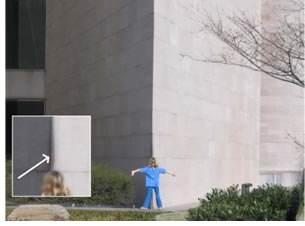 It’s easy to understand how our sense of touch is related to architectural
design. Textures and surfaces of building materials are felt by actual
contact or even by just imagining contact with them. For example, if
you have ever visited the East Building of the National Gallery of Art
in our nation’s capital, you may have noticed how many people cannot
resist touching the pointed edge of the stone projection just to the
right of the main entrance. I can feel the edge in my mind without even
touching it.
It’s easy to understand how our sense of touch is related to architectural
design. Textures and surfaces of building materials are felt by actual
contact or even by just imagining contact with them. For example, if
you have ever visited the East Building of the National Gallery of Art
in our nation’s capital, you may have noticed how many people cannot
resist touching the pointed edge of the stone projection just to the
right of the main entrance. I can feel the edge in my mind without even
touching it.
Likewise, you may not literally taste the materials in a building, but the design of a restaurant can have an impact on your “conditioned response” to the taste of the food there. And we all have our favorite smells in a building, as well as ones that are considered noxious. A cedar closet in the bedroom offers an easy example of a good smell. The terrible smell of a house ravaged by fire or floods is seared in the memory of those who have endured one of these disasters.
But we need to understand that our fingers don’t feel anything. Our noses cannot smell anything. And our taste buds and tongues cannot taste anything. It is the neuronal networks in our brains that create a sense of touch or smell or taste when signals are transmitted to them from sensory mechanisms. In this article, we will explore how those connections were created during our historical development, how they are formed in humans today, and how neuroscientists explain their performance.
Coming to our senses
Much like other mammals, we sharpened our senses of smell, taste, and
touch in our more primitive state. Earlier humans were able to recognize
each other, send signals (or messages) with body language, and remember
where their community was located and where in the community they lived
if they went hunting. Their brains had evolved over a long time to
enable them to do so. About 10,000 years ago, there was a watershed
in the development of the human brain when we began to read and write.
Before that, we were considered to be a two-legged mammal that was
anatomically related to the great apes, but distinguished by a more
highly developed brain that allowed the use of speech, abstract reasoning,
and the ability to walk erect—freeing the hand for manipulation
of all sorts.
Because it takes at least 50,000 years for minor mutations in the structure of the brain to become a permanent and common element for all of us, these newer abilities—language and abstract reasoning—had to use neuronal networks of the brain already present before 10,000 B.C. Therefore, as the ability to read emerged, it used the already established networks of the brain previously developed for seeing and hearing.
 It is interesting to note that the history of architecture also begins
around the time people started to read. Humans stopped being nomads,
settled into communities, and had the time and resources to design and
build places for their use. This turning point in architecture began
about 9000 B.C. One of the earliest surviving examples is an imposing
Neolithic town, dating from about 7000-6000 B.C. in Jordan and located
at the Biblical city of Jericho. The walls of this town were constructed
with surprising technical skill and doubtless intended as a defense against
enemies. Remember the Biblical account of Joshua blowing his trumpet
and “the walls came tumbling down”?
It is interesting to note that the history of architecture also begins
around the time people started to read. Humans stopped being nomads,
settled into communities, and had the time and resources to design and
build places for their use. This turning point in architecture began
about 9000 B.C. One of the earliest surviving examples is an imposing
Neolithic town, dating from about 7000-6000 B.C. in Jordan and located
at the Biblical city of Jericho. The walls of this town were constructed
with surprising technical skill and doubtless intended as a defense against
enemies. Remember the Biblical account of Joshua blowing his trumpet
and “the walls came tumbling down”?
Much later, a mysterious architectural setting was erected at Stonehenge. In its first phase, Stonehenge was a large earthwork; a bank and ditch were dug with tools made from the antlers of red deer and probably wood. About 2,000 BC, the first stone circle was set up, comprising bluestones weighing some two tons each. It was not until about 1,500 BC that this structure was completed (by unknown architects and builders). It seems clear that the abilities to use language and design and build structures were codependent developments in our early history.
When you were still in your mother’s womb, your brain developed in progressive stages based on a protomap (a kind of blueprint) passed on from generation to generation by DNA. The stages of brain development begin with our early responses to touch, pain, position, and temperature. These are followed soon thereafter by the vestibular system—the sensory systems of the middle ear—which detects motion and eventually will help us maintain our balance. The third set of systems to begin to function enable us to smell and taste. These are well established in the brain by the second trimester of fetal life. It is not until the third trimester that our ability to hear, and eventually to see, begins to develop.
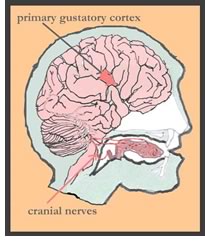 A matter of taste
A matter of taste
Inside the mouth, we have a large, extremely flexible tongue used for
eating, swallowing, and talking. Taste is determined by receptors on
the tongue called taste buds, the number and shape of which may vary
greatly from one person to the next. In general, women have more taste
buds than men. A larger number of taste buds appears to provide a greater
sensitivity to the four gustatory qualities: sweetness, saltiness,
sourness, and bitterness. Some of our taste preferences are hard-wired.
We have a special liking for sweet things, probably related to mother’s
milk. We instinctively reject things that are bitter tasting, probably
related to avoiding poisons in plants we might eat. We may sometimes
crave salty foods, when the body recognizes a deficiency in this key
nutrient.
The tongue is attached to the floor, or bottom, of the mouth. The taste buds are located on the surface of the tongue, with those at the tip used to transmit sweetness, those on the side used for saltiness and sourness, and those at the back transmit the sensation of bitterness. While the fibers from the taste buds transmit impulses directly to the brain, they need to be in a solution—the moisture created by the salivary glands. The cells of taste buds are constantly recycled every two weeks. It is these cells that use transduction mechanisms to change the chemicals in what we taste into electrical signals for the brain. For example, if you taste chicken soup, the sodium ions in the salt of the soup interact with the chemical process of a taste cell to release neurotransmitters to the axons of neurons in the thalamus that deal with sensory information from the head. From there, signals are sent to the “primary gustatory cortex” (see drawing). From there, various circuits control swallowing, memories (do we like chicken soup?), and eventually perception. It is not until the cortex registers the perception of salty that you have actually tasted anything. That’s why I indicated earlier that we do not taste with our tongue.
Our sense of smell
The information provided by the gustatory (taste) system combines with
olfactory (smell) information to create the sensation of flavor. The
nose, equipped with olfactory nerves (see illustration) is the special
organ of smell.
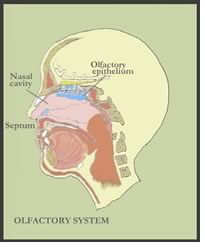 These nerves of smell terminate in the nasal cavity in several small
branches. These are embedded in the soft mucous membrane and are elongated
as epithelial cells projecting into the free surface of the nose in an
area called the “olfactory epithelium” (a thin layer of cells
that covers the nasal cavity).
These nerves of smell terminate in the nasal cavity in several small
branches. These are embedded in the soft mucous membrane and are elongated
as epithelial cells projecting into the free surface of the nose in an
area called the “olfactory epithelium” (a thin layer of cells
that covers the nasal cavity).
The olfactory nerves within the nose also determine differing tastes of substances taken into the mouth, i.e. many of our sensations of taste are really the brain response to smell. Research on smell has proposed that there are seven primary odors: camphorlike, musky, floral, peppermint, ethereal (dry cleaning fluid, for example), pungent (e.g. vinegar), and putrid that correspond to the seven types of smell receptors in the olfactory-cell hairs.
Studies have shown that the shape of an odor-causing chemical molecule determines the nature of the odor of that molecule. The process of absorbing these molecules is the first step. After the transmission of the impulses produced by these molecules on the olfactory nerve there is a transmission process through the brain that ends up with the perception of an odor by the brain. However, we lack a clear understanding of how information produced by odors is “understood” by the brain. Little progress has been made in determining how our brain perceives complex fragrances such as “chocolate” or “freshly baked bread.”
Even though we lack an understanding of how the brain identifies complex fragrances, we do know that our olfactory system can distinguish thousands of odors. For most animals, it is the primary mode of communication and influences many important functions. Scientists are just beginning to learn how the olfactory system works. Olfactory information travels to the cortex of the brain directly from the receptors in the nose, bypassing the thalamus through which all other sensory signals pass. The result of this bypass is that when we are asleep, we have no ability to smell fire or smoke. This is the reason you have a smoke detector in your bedroom (I hope).
For a reason still lost in evolutionary history, we can distinguish only three odors at any one time. For example, if you were exposed to the smell of banana, vanilla, and strawberry at one sitting, you would be okay. But if peppermint were added to the experience, you are not likely to be able to smell it. This might say something about an exposure to odors coming from the kitchen in a restaurant. Why this happens is believed to involve emotional responses and information from memories.
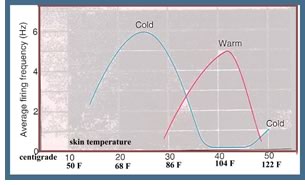 The complexity of touch
The complexity of touch
Our sense of touch enables us to differentiate objects by their texture
(stone is hard and putty is soft), vibration rate (your pulse is felt
via vibrations in one of your arteries), shape (a vase or a bottle),
pressure (if you pick up something weighing 2 pounds versus 20 pounds,
gravity exerts a different pressure), and temperature (hot and cold).
We all experience the sense of something being hot or cold when we touch it. But, we also know that the air in the space surrounding us registers on our skin as hot and cold, i.e., the room air is touching our skin. Thermoreceptors are neurons that are designed to be especially sensitive to temperature. We are able to perceive changes in our average skin temperature of a little as 0.01 degrees C. Temperature-sensitive neurons in the spinal cord and the hypothalamus maintain stable body temperature, but the thermoreceptors in the skin make it possible to perceive temperature. Warm receptors begin sending signals to the brain at about 30 degrees C (86 Fahrenheit) and increase their firing rate until about 45 degrees C (113 degrees F) (see diagram). As temperature increases further, the firing rate of these signals actually falls off. It is at 45 degrees C that we perceive changes from hot to scalding and tissues begin to burn. Cold receptors are relatively unresponsive to skin temperatures above about 35 degrees C (95 degrees F), but they fire faster over a broad range of descending temperatures down to about 10 degrees C (50 degrees F). Below that temperature, they stop firing and cold becomes an effective anesthetic, as you well know if you wade in icy mountain streams.
Response rates of warm and cold receptors are greatest during and shortly after quick temperature changes. Thus, if a teacher changes the settings on the thermostat in her classroom, her students will not notice it unless there is a rapid change in temperature, or until the temperature reaches a new sensitivity level.
The differences in our sense of touch are the result of responses to touch “receptors” that produce signals all over the body and transmit these signals via the spinal cord to the thalamus and then to the “somatic sensory” areas in the cortex of the brain. The cortex has regions that are dedicated to receiving signals from a particular body region. For example, there is a region (called the “top medial edge” of the somatic sensory area of the cortex) that responds to signals from the hips. Some parts of the body have much larger areas of the somatic sensory cortex devoted to them. They include the fingers, the toes, and the lips (which is why lovers hold hands and kiss).
What about pain? This complex phenomenon requires many parallel systems in the body. Sharp pain, such as pricking your finger with a pin, usually is brief, intense, and easy to localize. This pain is transmitted to the brain via a pathway of fast-conducting axons (the “trunks” of neurons). Deep, or dull pain, such as from a stomachache, usually is hard to localize and can last a long time. It is conducted by a pathway of slow-conducting axons, and they can tell us that something is hurting, but not where. It is not uncommon for deep pain to be activated by slow-conducting fibers on the surface of the body near where the actual pain is being produced as well as by a deep-pain pathway. So, for example, we might experience the pain of enlarged gallstones as a pain in the middle of the back. It is important to understand that we need pain to teach us to avoid harmful situations. It elicits quick reflexes from potentially harmful events (automatically withdrawing your hand when you touch a hot oven). And, pain exhorts us to rest an injured part of our body.
Proprioception
This critical sensory system is a sort of postscript to the five “conventional” senses
discussed above. If you have ever been given a sobriety test by a police
officer, in which you were required to touch your nose with your eyes
closed, you have experienced a special case of using proprioception.
People with too much alcohol in their system fail this test due to difficulty
locating their limbs in space relative to their noses.
Proprioception is the process by which the body non-consciously varies muscle contraction in immediate response to incoming information from external events or conscious thoughts. When considered with “kinesthesia” (the sense of joint motion), the combined feedback mechanisms control muscle responses and posture. These mechanisms also interact with the vestibular system, a fluid-filled area of the inner ear that responds to the pull of gravity and helps maintain balance. These mechanisms are used non-consciously (once we have trained our body to remember what to do) because we need to be conscious and selective in paying attention to the other senses. It would obviously be awkward to try to walk by thinking about each step we take and how we need to move our legs and feet.
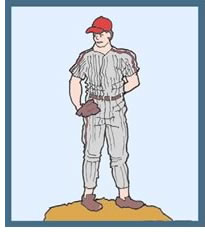 One way to illustrate the proprioceptive process is to go through the
steps a baseball pitcher takes when getting ready to pitch:
One way to illustrate the proprioceptive process is to go through the
steps a baseball pitcher takes when getting ready to pitch:
- Once he is on the mound, an umpire drops a ball into his outstretched hand. His muscle flex with the added weight, and the contraction of his hand and arm muscles hold the ball up against gravity.
- He now looks at the catcher (using his visual cortex) for a signal, while his ventromedial pathways are working to maintain his standing position, and neurons in his spinal cord are firing madly, keeping his legs ready to go.
- When he gets a signal—say for a curve ball—from the catcher, the sensory information is communicated to the cortex “Area 6” to begin planning a movement strategy for his body.
- When the batter is ready, the basal ganglia in the pitcher’s brain increase their activity to trigger the initiation of the pitch. The cerebellum gets information from his memory and prepares instructions on the sequence for the various muscles of the body.
- A signal is sent to the motor neurons via the spinal cord, causing them to contract in a proper sequence.
- The pitcher throws the curve ball, and his cerebellum goes back to work to begin making adjustments for the next pitch. It stores this information in a neuromatrix, or map in the brain that was installed at birth by DNA from his parents.
Isn’t all of this more technical
than architects need to know?
Maybe. It depends on how much effort you are willing to make to begin
to understand this new body of knowledge. In the next few articles,
we will explore ways that the brain and the mind shape our experiences
of health-care facilities, schools, churches, laboratories, and facilities
for the aging.
If you have read and absorbed this article and the first three (see reference column), you will be ready to think about these facility design questions in new ways. I will tell you about the results of workshops the Academy of Neuroscience for Architecture has had over the past three years. Working sessions between architects and neuroscientists shaped the hypotheses that emerged from these workshops. Each discipline found that it was able to converse with the other after some initial effort was made. I think you will find it intellectually rewarding to join us in this journey of discovery.
Copyright 2006 The American Institute of Architects.
All rights reserved. Home Page ![]()
![]()
For more information, visit the Academy of Neuroscience for Architecture Web site.
Read the other three articles in this series:
• See the Space and Hear the Sound of Music
How we use the brain and mind to see and hear
• Thanks for the Memories
The brain, the mind, and creation of memories
• You Need to Know What You Don't Know
Read this introductory article by the author:
The Neuroscience in A Christmas Carol
A tale of conception, perception, and proprioception
![]()